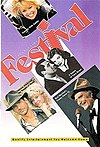Festival (TV channel)
 | |
| Country | United States |
|---|---|
| Broadcast area | Nationwide (in select markets) |
| Headquarters | New York City, New York |
| Programming | |
| Language(s) | English |
| Ownership | |
| Owner | Home Box Office, Inc. (Time Inc.) |
| Sister channels | HBO Cinemax |
| History | |
| Launched | April 1, 1986 |
| Closed | December 31, 1988 |
Festival was an American premium cable television network that was owned by Home Box Office, Inc., then a subsidiary of Time Inc., and operated from 1986 to 1988. The channel's programming consisted of uncut and re-edited versions of recent older theatrically released motion pictures, along original music, comedy and nature specials sourced from the parent HBO channel aimed at a family audience.
History
[edit]
On April 1, 1986, HBO began test-marketing a tertiary premium service, Festival, to an estimated 850 subscribers over six cable systems owned by then-sister company American Television and Communications Corporation (eventually expanding to 25 systems by the Summer of 1986).[1][2][3][4] The channel—which transmitted for 19 hours each day from 7:00 a.m. to 2:00 a.m. Eastern Time daily—was targeted at older audiences who found programming containing violence and sexual situations on other premium services objectionable, television viewers without cable service, and basic cable subscribers that opted against retaining a subscription to a premium service.[3][5] Its slogan, Quality Entertainment You Welcome Home, reflected the target audience it was trying to attract.[6]
Primarily to cater to the former demographic, Festival focused around family-friendly fare that included classic and recent hit movies (including collections of feature films starring a featured actor, known as "Star Salutes"), and documentaries, along with HBO original stand-up comedy, concert, nature and ice skating specials (which Festival branded under the "Centerstage" banner). Atypical for a premium service, Festival aired "airline-style" versions of R-rated movies re-edited to fit a PG rating on the channel's schedule.[6][7]
As Festival was designed as a mini-pay premium service (similar to Take 2—HBO's first attempt at a complimentary pay service from 1979 to 1981—before it), subscription pricing for the channel was set lower than that of HBO and Cinemax (between $2.99 and $6.99 per month—equivalent to between $7.05 and $16.48 in 2023, adjusted for inflation[8]—depending on the cable system). Festival also provided subscribers with a 20-page, color monthly program guide. Like HBO, Festival also ran occasional free preview periods, such as the October 30 to November 2, 1987, preview hosted by Tony Randall.
On July 14, 1988, Home Box Office, Inc. announced it would shut down Festival at the end of the year, citing headend channel capacity limitations that prevented Festival from expanding beyond the 102 systems that already carried the service. The channel had reoriented its marketing initiatives to aggressively target cable subscribers who subscribed to another pay service. At its peak, Festival had an estimated 30,000 subscribers by the Summer of 1988, putting it at a distant last place in total subscriber reach among the eight American premium cable services operating at the time. (By comparison, during the same timeframe, HBO had reached 15.9 million subscribers and fellow sister channel Cinemax reached 5.1 million, while Festival's most direct competitor, The Disney Channel—then also a family-oriented premium service until it shifted to basic cable in April 1997—had 3.18 million subscribers.) Festival ceased operations on December 31, 1988.[9][1][10][11][12]
References
[edit]- ^ a b Festival program guide, Home Box Office, Inc., 1987
- ^ "Burgeoning world of cable programing" (PDF). Broadcasting. Broadcasting Publications Inc. June 16, 1986. p. 10. Retrieved May 17, 2020 – via American Radio History.
"Burgeoning world of cable programing" (PDF). Broadcasting. Broadcasting Publications Inc. June 16, 1986. p. 11. Retrieved May 17, 2020 – via American Radio History. - ^ a b "Cablecastings: Festival expansion" (PDF). Broadcasting. Broadcasting Publications Inc. April 7, 1986. p. 10. Retrieved May 17, 2020 – via American Radio History.
- ^ Michael Schneider (December 2, 2020). "13 TV Networks That Pulled a Quibi and Died a Quick Death". Variety. Retrieved January 17, 2021.
- ^ David Crook (February 15, 1986). "HBO Plans To Test New Pay Channel". Los Angeles Times. Retrieved July 22, 2020.
- ^ a b Festival program guide, Home Box Office, Inc., January 1988, p. Front cover
- ^ Thomas Morgan (February 17, 1986). "HBO Launching Service To Attract Older Audience". Fort Lauderdale Sun-Sentinel. Times Mirror Company. Archived from the original on 2013-05-27. Retrieved 2020-05-20.
- ^ As calculated by the US Bureau of Statistics' CPI Inflation Calculator
- ^ Bill Mesce (November 6, 2013). "It's Not TV: HBO, The Company That Changed Television: Expanding The Brand (Part 1)". Sound on Sight. Archived from the original on February 2, 2014. Retrieved February 1, 2014.
- ^ "HBO changes marketing plan for Festival" (PDF). Broadcasting. Broadcasting Publications Inc. June 20, 1988. p. 53. Retrieved May 16, 2020 – via American Radio History.
- ^ "The Cable Network Programing Universe" (PDF). Broadcasting. Broadcasting Publications Inc. May 30, 1988. p. 41. Retrieved May 17, 2020 – via American Radio History.
- ^ "HBO's Festival to go dark" (PDF). Broadcasting. Broadcasting Publications Inc. July 18, 1988. p. 61. Retrieved May 17, 2020 – via American Radio History.
External links
[edit]- HBO
- Home Box Office, Inc.
- Commercial-free television networks in the United States
- Movie channels in the United States
- English-language television stations in the United States
- Defunct television networks in the United States
- Television channels and stations established in 1986
- Television channels and stations disestablished in 1988
